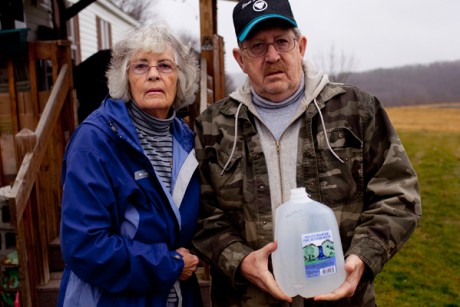Confirmed: fracking can pollute is a new article in Salon that reports on a new study by the National Academy of Sciences, a group that is not wholly funded by Chinapeake Energy, like the Buffalo University Shale Shamstitute of Frackademics
Shale gas wells can leak all sorts of ways – either by contaminating natural up-flows of water, like those that drive thermal and mineral springs into ground water and water wells , or by simply leaking up the outside of the casing. They are in fact, a textbook way of mobilizing gas into groundwater. This new peer-reviewed research suggests – that deep water formations that could be contaminated by a frack or leaking (‘fugitive’) gas from a well do in fact communicate with shallow aquifers that are tapped for drinking water. As they say, “Let the scientists decide.” You know like this: National Academy of Science Fracking Study
Note that the study simply pointed out that there is communication from lower strata of water exposed to fracking, and aquifers tapped by water wells. (This communication is something the fracking apologists have either ignored or downplayed.) The actual migration of fracking fluids is another matter – a matter of time and volume. If the communication is manifested in the form of a thermal spring (Old Faithful at Yellowstone) then a matter of hours. These are geological and hydrological vectors. The more prosaic pathway is the wellbore itself; the outermost casing separates from the rock and gas goes up the wellbore. All wellbores will leak sooner or later, simply a matter of how much how soon, because gas wellbores leak
MONDAY, JUL 9, 2012 03:00 PM EDT
Confirmed: Fracking can pollute
A new study explodes the gas industry’s claim that fracking won’t contaminate local drinking water
BY SARAH LASKOW
TOPICS: ENVIRONMENT, FRACKING
 Ron and Jean Carter hold a bottle of well water outside their home in Dimock, Pennsylvania. The Carters are suing Cabot Energy for allegedly poisoning their well with toxic chemicals and water. (Reuters/Les Stone)
Ron and Jean Carter hold a bottle of well water outside their home in Dimock, Pennsylvania. The Carters are suing Cabot Energy for allegedly poisoning their well with toxic chemicals and water. (Reuters/Les Stone)
One of the key arguments in the case for fracking rests on an appeal to common sense. The hydraulic fracturing process — pushing gallons upon gallons of chemical-laden water into shale rock in order to bubble up natural gas — takes place deep in the ground, thousands of feet below the earth’s surface and thousands of feet below the shallow aquifers that provide drinking water. Given the distance between the water and the fracking fluid, there’s just no way fracking could contaminate aquifers, the gas industry and its allies argue. So many layers of rock lie between noxious fracking fluid and water that the risks of chemical-laced drinking water don’t compute.
But that is not how it works down there . . . deeper water that can be contaminated moves upwards
Study: Fluids From Marcellus Shale Likely Seeping Into PA Drinking Water

ProPublica, July 9, 2012, 3 p.m.






{ 10 comments… read them below or add one }
What a shocker!
a contrarian point of view
“what’s most notable about this paper – similar to the first — is what the authors did not find: no fracturing fluids in water wells, and no correlation between the phenomena they report and activities associated with natural gas development. According to the paper: “The occurrences of saline water do not correlate with the location of shale-gas wells and are consistent with reported data before rapid shale-gas development in the region”
http://www.energyindepth.org/another-duke-rebuke/
Hey, new guy, PAK- As much as I appreciate you citing your source instead of what most frackers do in just shooting their frackin mouth off, EID was created by, and fully funded by Industry. They have been outed as Paid Liars. All they ever said was “There’s no such thing as ground water contamination due to hydraulic fracturing.” Then, one of their Gods, Kathryn Klaber, admitted to ground water contamination. Then Aubrey admitted it. Now that they have admitted what we’ve known for years, they are ignoring it and simply trying to change the subject. No one at EID tries to tell this lie anymore. Try to keep up, willya?
Shale gas drilling, fracking and production has and is contaminating our drinking water–and the paths of migration are many and varied. And you must understand that shale gas operations are much worse that the old timy oil wells with “west Texas pumper” on them where that is no natural surfact pressure from the oil. In gas wells, the pressure is HIGH and long lived and that is a major factor of differences from days of old and the new era of shale operations that are causing this new water contamination. There are many other factors.
No surprisingly, most of these papers from hydrologists and geologists focus on the natural vectors of contaminants, faulting, thermal water uplifts, etc. Not on the more prosaic mechanism of the wellbore becoming a pathway for pollution as it ages. Which the industry knows is the most likely problem. Over time all of those wellbores will leak – just a matter of when and how much.
http://www.scribd.com/doc/65577477/How-Gas-Wells-Leak
How true Chip. And even with an idealized and perfect shale gas well drilled into a formation deep enough, so that when fracking takes place, the fracture results in a “vertical fracture”, a migratory path can go from that point to a nearby old P&A’d oil well (whiich now has corroded casing and bad cement) and was P&A’d based on no surface pressure, and on up into the water aquifers–and here we go. And there are many more situations.
In Texas, the TRRC does not require tubing to be installed in gas wells. Lots of tubingless completions out there—and if you think that tubingless completions are bad, be aware that the TRRC does not even require any casing (except for surface casing) to be installed in a producing well in Texas. So that leaves us with thousands of tubingless and casingless (expect for surface casing) in our midst to provide enabling migratory pathways up to drinking water aquifers!!!! Because we have shale gas drilling in our midst, get ready for upcoming bad water problems. Maybe invest in desalination plants/equipment–we are gonna need ‘em.
Who needs hydrologists and geologists to write papers when you have open hole completions . . .
Yep–open hole completions–that’s another way to properly identify just this type of “bad wells”.
So if it does contaminate the water I wonder what’s going to happen to that one Governor that drank the fracking fluid